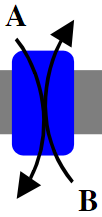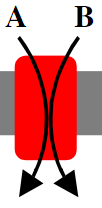Cotransporter
Cotransporters are a subcategory of

Background
Cotransporters are capable of moving solutes either up or down gradients at rates of 1000 to 100000 molecules per second. They may act as channels or transporters, depending on conditions under which they are assayed. The movement occurs by binding to two molecules or ions at a time and using the gradient of one solute's concentration to force the other molecule or ion against its gradient. Some studies show that cotransporters can function as ion channels, contradicting the classical models. For instance the wheat HKT1 transporter shows two modes of transport by the same protein.[2]
Cotransporters can be classified as
History

Dr.
Mechanism
Antiporters and symporters both transport two or more different types of molecules at the same time in a coupled movement. An energetically unfavored movement of one molecule is combined with an energetically favorable movement of another molecule(s) or ion(s) to provide the power needed for transport. This type of transport is known as
Cotransporters undergo a cycle of conformational changes by linking the movement of an ion with its concentration gradient (downhill movement) to the movement of a cotransported solute against its concentration gradient (uphill movement).[5] In one conformation the protein will have the binding site (or sites in the case of symporters) exposed to one side of the membrane. Upon binding of both the molecule which is to be transported uphill and the molecule to be transported downhill a conformational change will occur. This conformational change will expose the bound substrates to the opposite side of the membrane, where the substrates will disassociate. Both the molecule and the cation must be bound in order for the conformational change to occur. This mechanism was first introduced by Oleg Jardetzky in 1966.[6] This cycle of conformational changes only transports one substrate ion at a time, which results in a fairly slow transport rate (100 to 104 ions or molecules per second) when compared to other transport proteins like ion channels.[1] The rate at which this cycle of conformational changes occurs is called the turnover rate (TOR) and is expressed as the average number of complete cycles per second performed by a single cotransporter molecule.[5]
Types


Antiporters
Antiporters use the mechanism of cotransport (coupling the movement of one ion or molecule down its concentration gradient with the transport of another ion or molecule up its concentration gradient), to move the ions and molecule in opposite directions.
Cells also contain
Symporters
In contrast to antiporters, symporters move ions or molecules in the same direction.
Examples of cotransporters
Na+/phosphate cotransporter (NaPi) – Sodium-phosphate cotransporters are from the SLC34 and SLC20 protein families. They are also found across the epithelial cells of renal proximal tubule and of the small intestine. It transfers inorganic phosphate into cells through active transport with the help of a Na+ gradient. Similar to SGTL1, they are classified as electrogenic transporters. NaPi coupled with 3 Na+ ions and 1 divalent Pi, are classified as NaPi IIa and NaPi IIb. NaPi that couples with 2 Na+ and 1 divalent Pi are classified as NaPi IIc.[11][13]
Associated diseases
Table 1: List of diseases related to transporters.[21]
| Transporter Symbols/Names | Relevant Diseases |
|---|---|
| 4F2HC, SLC3A2 | Lysinuric |
| ABC-1, ABC1 | Tangier disease |
| ABC7, hABC7 | X-linked sideroblastic anemia |
| ABCR | Fundus flavimaculatus
|
| AE1, SLC4A1 | |
| AE2, SLC4A2 | congenital chloroidorrhea |
| AE3, SLC4A3 | congenital chloroidorrhea |
| ALDR | Adrenoleukodystrophy |
| ANK | ankylosis (calcification); arthritis accompanied by mineral deposition, formation of bony outgrowths, and joint destruction |
| Aralar-like, SLC25A13 | adult-onset type II citrullinemia |
| ATBo, SLC1A5, hATBo, ASCT2, AAAT | Neurodegeneration
|
| BCMP1, UCP4, SLC25A14 | HHH |
| CFTR | Cystic fibrosis |
| CTR-1, SLC31A1 | Menkes/ Wilsons disease
|
| CTR-2, SLC31A2 | Menkes/Wilsons disease, X-linked hypophosphatemia |
| DTD, SLC26A2 | chondrodysplasias/ Diastrophic dysplasia |
| EAAT1, SLC1A3, GLAST1 | Amyotrophic lateral sclerosis
|
| EAAT2, SLC1A2, GLT-1 | Neurodegeneration, Dicarboxylic aminoaciduria |
| EAAT3, SLC1A1, EAAC1 | Neurodegeneration |
| EAAT4, SLC1A6 | Neurodegeneration |
| EAAT5, SLC1A7 | Neurodegeneration |
| FIC1 | Progressive familial intrahepatic cholestasis |
| FOLT, SLC19A1, RFC1 | Folate malabsorption/megaloblastic anemia |
| GLUT1, SLC2A1 | low CNS glucose causing diabetes mellitus , defect in glucose transport across the blood-brain barrier
|
| GLUT2, SLC2A2 | low CNS glucose causing seizures, Fanconi-Bickel syndrome, Glycogen storage disease type Id, Non-insulin-dependent diabetes mellitus (NIDDM) |
| GLUT3, SLC2A3 | low CNS glucose causing seizures, Fanconi-Bickel syndrome, Glycogen storage disease type Id, Non-insulin-dependent diabetes mellitus (NIDDM) |
| GLUT4, SLC2A4 | low CNS glucose causing seizures, Fanconi-Bickel syndrome, Glycogen storage disease type Id, Non-insulin-dependent diabetes mellitus (NIDDM) |
| GLUT5, SLC2A5 | Isolated fructose malabsorption |
| HET | hemochromatosis
|
| HTT, SLC6A4 | anxiety-related traits |
| LAT-2, SLC7A6 | Lysinuric protein intolerance |
| LAT-3, SLC7A7 | lysinuric protein intolerance |
| MDR1 | human cancers |
| MDR2, MDR3 | Familia intrahepatic cholestasis |
| MRP1 | human cancers |
| NBC | Down syndrome |
| NBC1, SLC4A4 | renal tubular acidosis |
| NBC3, SLC4A7 | congenital hypothyroidism |
| NCCT, SLC12A3, TSC | Gitelman syndrome |
| NHE2, SLC9A2 | Microvillus inclusion disease
|
| NHE3, SLC9A3/3P | Microvillus inclusion disease |
| NIS, SLC5A5 | congenital hypothyroidism |
| NKCC1, SLC12A2 | gitelman syndrome |
| NKCC2, SLC12A1 | Bartter syndrome |
| NORTR | velocardiofacial syndrome
|
| NRAMP2, DCT1, SLC11A2, | Attention deficit hyperactivity disorder |
| NTCP2, ISBT, SLC10A2 | primary bile acid malabsorption (PBAM) |
| OCTN2, SLC22A5 | systemic carnitine deficiency (progressive sudden infant death syndrome )
|
| ORNT1, SLC25A15 | HHH |
| PMP34, SLC25A17 | Graves disease
|
| rBAT, SLC3A1, D2 | cystinuria |
| SATT, SLC1A4, ASCT1 | Neurodegeneration |
| SBC2 | hypocitraturia |
| SERT | various mental disorders |
| SGLT1, SLC5A1 | renal glucosuria / glucose-galactose malabsorption
|
| SGLT2, SLC5A2 | renal glucosuria |
| SMVT, SLC5A6 | anxiety-related traits, depression |
| TAP1 | juvenile onset psoriasis |
| y+L | Type I cystinuria |
See also
- Na-K-2Cl symporter
- K-Cl cotransporter
- Sodium/phosphate cotransporter
- Sodium-glucose transport proteins
- Glucose transporter
- Cystic fibrosis
References
- ^ ISBN 978-1-4292-3413-9.
- ^ PMID 10213785.
- PMID 18660845.
- PMID 23525627.
- ^ PMID 21190656.
- S2CID 4178898.
- S2CID 6963309.
- ISBN 978-0716737063.
- S2CID 41985805.
- PMID 8599647.
- ^ a b c d Physiologyweb. "Secondary Active Transport". Physiologyweb. Retrieved 4 December 2013.
- PMID 15546855.
- PMID 23398154.
- PMID 22011571.
- S2CID 42069918.
- PMID 7943281.
- S2CID 21998913.
- ^ OMIM Entry. "137165 - SOLUTE CARRIER FAMILY 6 (NEUROTRANSMITTER TRANSPORTER, GABA), MEMBER 1; SLC6A1". Johns Hopkins University. Retrieved 8 December 2013.
- ^ GeneCads. "SLC6A11 Gene". Weizmann Institute of Science. Retrieved 8 December 2013.
- PMID 10913127.
- ^ "Membrane Transporter-Related Diseases « Membrane Transporter Database for Personalized Medicine". pharmtao.com.
